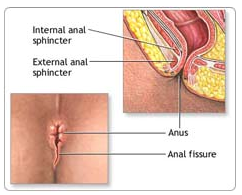FissureSurgical therapy is usually reserved for acute anal fissures that remain symptomatic after 3-4 weeks of medical therapy and for chronic anal fissures. Preoperative Details This is the current surgical procedure of choice. The procedure can be performed with the patient under general or spinal anesthesia. (Local anesthesia may even be used in the cooperative patient, although this is not always recommended). The purpose of an internal sphincterotomy is to cut the hypertrophied internal sphincter, thereby releasing tension and allowing the fissure to heal. Intraoperative Details Sphincter dilatation This procedure is a controlled anal stretch or dilatation under general anesthetic. This is performed because one of the causative factors for anal fissure is thought to be a tight internal anal sphincter; stretching it helps to correct the underlying abnormality, thus allowing the fissure to heal. The number of fingers used and the amount of time the stretch is applied varies among surgeons. While the sphincter stretch does provide symptomatic relief from the anal fissure, it is rarely performed today, because of the high complication rate. Impaired continence is observed in 12-27% of patients because of the uncontrolled stretching and subsequent tearing of the internal and external sphincter. 
Lateral internal sphincterotomy This is the current surgical procedure of choice. The procedure can be performed with the patient under general or spinal anesthesia. (Local anesthesia may even be used in the cooperative patient, although this is not always recommended). The purpose of an internal sphincterotomy is to cut the hypertrophied internal sphincter, thereby releasing tension and allowing the fissure to heal When first described, the sphincterotomy was performed in the posterior midline at the site of the fissure, with or without a fissurectomy. However, the incision for the sphincterotomy usually did not heal for exactly the same reason that the fissure did not heal. Now, sphincterotomies are normally performed in the lateral quadrants (right or left, depending on the comfort or handedness of the surgeon). In a properly performed lateral internal sphincterotomy, only the internal sphincter is cut; the external sphincter is not cut and must not be injured The sphincterotomy can be performed in either an open or a closed manner. In a closed sphincterotomy, a No. 11 blade is inserted sideways into the intersphincteric groove laterally. It is then rotated medially and drawn out to cut the internal sphincter. Care is taken to not cut the anal mucosa, because this could result in a fistula. After the knife is removed, the anal mucosa overlying the sphincterotomy is palpated, and a gap in the internal sphincter can be felt through it. The sphincterotomy is extended into the anal canal for a distance equal to the length of the anal fissure. In an open sphincterotomy, a 0.5- to 1-cm incision is made in the intersphincteric plane. The internal sphincter is then looped on a right angle and brought up into the incision. The internal sphincter is then cut under direct visualization. The 2 ends are allowed to fall back after being cut. A gap can then be palpated in the internal sphincter through the anal mucosa, as in the closed technique. The incision can be closed or left open to heal. In the treatment of chronic anal fissures, the surgeon may choose to excise the fissure in conjunction with the lateral sphincterotomy. Take care not to include a piece of the internal sphincter with the excision. More simply, instead of excising the fissure along with the sphincterotomy and worrying whether it will heal, the surgeon can excise the hypertrophied papillae and the skin tag and leave the fissure to heal on its own. Sometimes, long-standing chronic fissures do not heal, even with an adequate sphincterotomy, and an advancement flap must be performed to cover the defect in the mucosa. This can be performed either at the time of the sphincterotomy if the surgeon does not think that the fissure will heal or as a second procedure if the fissure does not heal. Postoperative Details Sphincterotomy is performed either in an outpatient setting or as an office procedure, and patients return home the same day. Typically, minimal postoperative pain is associated with either the closed or open technique—usually no more than the fissure caused preoperatively. Pain from the fissure starts to abate almost immediately. The only postoperative restrictions are from the anesthetic, and many patients can return to normal activities the following day |

+91 - 95661 39630
+91 - 94441 68963



